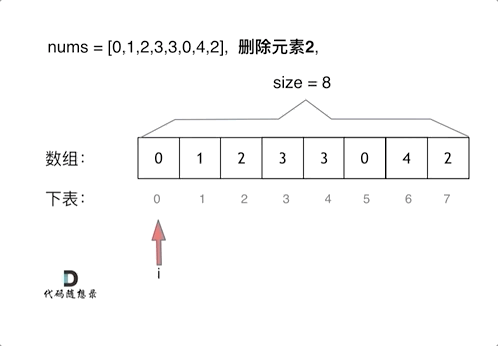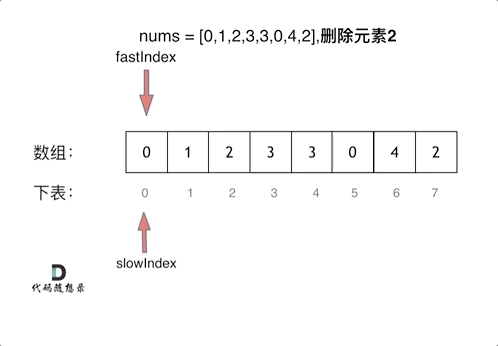参与本项目,贡献其他语言版本的代码,拥抱开源,让更多学习算法的小伙伴们收益!
给你一个数组 nums 和一个值 val,你需要 原地 移除所有数值等于 val 的元素,并返回移除后数组的新长度。
不要使用额外的数组空间,你必须仅使用 O(1) 额外空间并原地修改输入数组。
元素的顺序可以改变。你不需要考虑数组中超出新长度后面的元素。
示例 1: 给定 nums = [3,2,2,3], val = 3, 函数应该返回新的长度 2, 并且 nums 中的前两个元素均为 2。 你不需要考虑数组中超出新长度后面的元素。
示例 2: 给定 nums = [0,1,2,2,3,0,4,2], val = 2, 函数应该返回新的长度 5, 并且 nums 中的前五个元素为 0, 1, 3, 0, 4。
你不需要考虑数组中超出新长度后面的元素。
针对本题,我录制了视频讲解:数组中移除元素并不容易!LeetCode:27. 移除元素,结合本题解一起看,事半功倍!
有的同学可能说了,多余的元素,删掉不就得了。
要知道数组的元素在内存地址中是连续的,不能单独删除数组中的某个元素,只能覆盖。
数组的基础知识可以看这里程序员算法面试中,必须掌握的数组理论知识。
这个题目暴力的解法就是两层for循环,一个for循环遍历数组元素 ,第二个for循环更新数组。
删除过程如下:
很明显暴力解法的时间复杂度是O(n^2),这道题目暴力解法在leetcode上是可以过的。
代码如下:
// 时间复杂度:O(n^2)
// 空间复杂度:O(1)
class Solution {
public:
int removeElement(vector<int>& nums, int val) {
int size = nums.size();
for (int i = 0; i < size; i++) {
if (nums[i] == val) { // 发现需要移除的元素,就将数组集体向前移动一位
for (int j = i + 1; j < size; j++) {
nums[j - 1] = nums[j];
}
i--; // 因为下标i以后的数值都向前移动了一位,所以i也向前移动一位
size--; // 此时数组的大小-1
}
}
return size;
}
};- 时间复杂度:O(n^2)
- 空间复杂度:O(1)
双指针法(快慢指针法): 通过一个快指针和慢指针在一个for循环下完成两个for循环的工作。
定义快慢指针
- 快指针:寻找新数组的元素 ,新数组就是不含有目标元素的数组
- 慢指针:指向更新 新数组下标的位置
很多同学这道题目做的很懵,就是不理解 快慢指针究竟都是什么含义,所以一定要明确含义,后面的思路就更容易理解了。
删除过程如下:
很多同学不了解
双指针法(快慢指针法)在数组和链表的操作中是非常常见的,很多考察数组、链表、字符串等操作的面试题,都使用双指针法。
后续都会一一介绍到,本题代码如下:
// 时间复杂度:O(n)
// 空间复杂度:O(1)
class Solution {
public:
int removeElement(vector<int>& nums, int val) {
int slowIndex = 0;
for (int fastIndex = 0; fastIndex < nums.size(); fastIndex++) {
if (val != nums[fastIndex]) {
nums[slowIndex++] = nums[fastIndex];
}
}
return slowIndex;
}
};注意这些实现方法并没有改变元素的相对位置!
- 时间复杂度:O(n)
- 空间复杂度:O(1)
/**
* 相向双指针方法,基于元素顺序可以改变的题目描述改变了元素相对位置,确保了移动最少元素
* 时间复杂度:O(n)
* 空间复杂度:O(1)
*/
class Solution {
public:
int removeElement(vector<int>& nums, int val) {
int leftIndex = 0;
int rightIndex = nums.size() - 1;
while (leftIndex <= rightIndex) {
// 找左边等于val的元素
while (leftIndex <= rightIndex && nums[leftIndex] != val){
++leftIndex;
}
// 找右边不等于val的元素
while (leftIndex <= rightIndex && nums[rightIndex] == val) {
-- rightIndex;
}
// 将右边不等于val的元素覆盖左边等于val的元素
if (leftIndex < rightIndex) {
nums[leftIndex++] = nums[rightIndex--];
}
}
return leftIndex; // leftIndex一定指向了最终数组末尾的下一个元素
}
};- 26.删除排序数组中的重复项
- 283.移动零
- 844.比较含退格的字符串
- 977.有序数组的平方
Java:
class Solution {
public int removeElement(int[] nums, int val) {
// 快慢指针
int slowIndex = 0;
for (int fastIndex = 0; fastIndex < nums.length; fastIndex++) {
if (nums[fastIndex] != val) {
nums[slowIndex] = nums[fastIndex];
slowIndex++;
}
}
return slowIndex;
}
}//相向双指针法
class Solution {
public int removeElement(int[] nums, int val) {
int left = 0;
int right = nums.length - 1;
while(right >= 0 && nums[right] == val) right--; //将right移到从右数第一个值不为val的位置
while(left <= right) {
if(nums[left] == val) { //left位置的元素需要移除
//将right位置的元素移到left(覆盖),right位置移除
nums[left] = nums[right];
right--;
}
left++;
while(right >= 0 && nums[right] == val) right--;
}
return left;
}
}Python:
(版本一)快慢指针法
class Solution:
def removeElement(self, nums: List[int], val: int) -> int:
# 快慢指针
fast = 0 # 快指针
slow = 0 # 慢指针
size = len(nums)
while fast < size: # 不加等于是因为,a = size 时,nums[a] 会越界
# slow 用来收集不等于 val 的值,如果 fast 对应值不等于 val,则把它与 slow 替换
if nums[fast] != val:
nums[slow] = nums[fast]
slow += 1
fast += 1
return slow(版本二)暴力法
class Solution:
def removeElement(self, nums: List[int], val: int) -> int:
i, l = 0, len(nums)
while i < l:
if nums[i] == val: # 找到等于目标值的节点
for j in range(i+1, l): # 移除该元素,并将后面元素向前平移
nums[j - 1] = nums[j]
l -= 1
i -= 1
i += 1
return l
Go:
func removeElement(nums []int, val int) int {
length:=len(nums)
res:=0
for i:=0;i<length;i++{
if nums[i]!=val {
nums[res]=nums[i]
res++
}
}
nums=nums[:res]
return res
}//相向双指针法
func removeElement(nums []int, val int) int {
// 有点像二分查找的左闭右闭区间 所以下面是<=
left := 0
right := len(nums) - 1
for left <= right {
// 不断寻找左侧的val和右侧的非val 找到时交换位置 目的是将val全覆盖掉
for left <= right && nums[left] != val {
left++
}
for left <= right && nums[right] == val {
right--
}
//各自找到后开始覆盖 覆盖后继续寻找
if left < right {
nums[left] = nums[right]
left++
right--
}
}
fmt.Println(nums)
return left
}JavaScript:
//时间复杂度:O(n)
//空间复杂度:O(1)
var removeElement = (nums, val) => {
let k = 0;
for(let i = 0;i < nums.length;i++){
if(nums[i] != val){
nums[k++] = nums[i]
}
}
return k;
};TypeScript:
function removeElement(nums: number[], val: number): number {
let slowIndex: number = 0, fastIndex: number = 0;
while (fastIndex < nums.length) {
if (nums[fastIndex] !== val) {
nums[slowIndex++] = nums[fastIndex];
}
fastIndex++;
}
return slowIndex;
};Ruby:
def remove_element(nums, val)
i = 0
nums.each_index do |j|
if nums[j] != val
nums[i] = nums[j]
i+=1
end
end
i
endRust:
impl Solution {
pub fn remove_element(nums: &mut Vec<i32>, val: i32) -> i32 {
let mut slowIdx = 0;
for pos in (0..nums.len()) {
if nums[pos]!=val {
nums[slowIdx] = nums[pos];
slowIdx += 1;
}
}
return (slowIdx) as i32;
}
}Swift:
func removeElement(_ nums: inout [Int], _ val: Int) -> Int {
var slowIndex = 0
for fastIndex in 0..<nums.count {
if val != nums[fastIndex] {
nums[slowIndex] = nums[fastIndex]
slowIndex += 1
}
}
return slowIndex
}PHP:
class Solution {
/**
* @param Integer[] $nums
* @param Integer $val
* @return Integer
*/
function removeElement(&$nums, $val) {
if (count($nums) == 0) {
return 0;
}
// 快慢指针
$slow = 0;
for ($fast = 0; $fast < count($nums); $fast++) {
if ($nums[$fast] != $val) {
$nums[$slow] = $nums[$fast];
$slow++;
}
}
return $slow;
}C:
int removeElement(int* nums, int numsSize, int val){
int slow = 0;
for(int fast = 0; fast < numsSize; fast++) {
//若快指针位置的元素不等于要删除的元素
if(nums[fast] != val) {
//将其挪到慢指针指向的位置,慢指针+1
nums[slow++] = nums[fast];
}
}
//最后慢指针的大小就是新的数组的大小
return slow;
}Kotlin:
fun removeElement(nums: IntArray, `val`: Int): Int {
var slowIndex = 0 // 初始化慢指针
for (fastIndex in nums.indices) {
if (nums[fastIndex] != `val`) nums[slowIndex++] = nums[fastIndex] // 在慢指针所在位置存储未被删除的元素
}
return slowIndex
}Scala:
object Solution {
def removeElement(nums: Array[Int], `val`: Int): Int = {
var slow = 0
for (fast <- 0 until nums.length) {
if (`val` != nums(fast)) {
nums(slow) = nums(fast)
slow += 1
}
}
slow
}
}C#:
public class Solution {
public int RemoveElement(int[] nums, int val) {
int slow = 0;
for (int fast = 0; fast < nums.Length; fast++) {
if (val != nums[fast]) {
nums[slow++] = nums[fast];
}
}
return slow;
}
}


